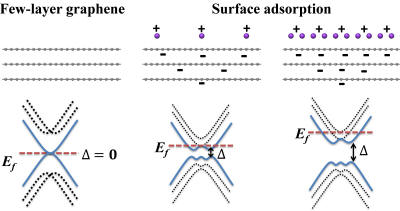Time:2013-05-12ClickTimes:
The extremely high mobility of graphene renders it an ideal candidate for
future nanoelectronics, but its zero band gap nature makes it not suitable
for a field effect transistor (FET) operating at room temperature. Thus
opening a tunable band gap without degrading its electronic properties is
one of the most important and urgent research topics in graphene community.
Based on the previous works of band gap engineering in single layer graphene
(NPG Asia Materials 4, e6(2012);http://www.nature.com/doifinder/10.1038/am.2012.10)
and silicene (Scientific Reports 2, 853(2012); http://www.nature.com/srep/2012/121114/srep00853/full/srep00853),
the Computational Materials Group led by Prof. Jing Lu at School of Physics,
Peking University further proposes that the single-side surface adsorption
can open a band gap in few-layer graphene (FLG). The density functional
theory calculations reveal that this surface adsorption scheme can open a
gap by effectively breaking the symmetry of ABC-stacked graphene without
degrading the high carrier mobility of graphene. By changing the adsorption
coverage and the type of adsorbates, the size of the band gap is tunable.
Notably, even the band gap of ABA-stacked FLG can be opened if the bond
symmetry is broken by surface adsorption though a uniform external electric
field fails to open a band gap in it. By using ab initio quantum transport
calculation, a transport gap is found in the single-gated Cu-adsorbed
ABC-stacked trilayer FET device, suggesting that metal-adsorbed FLG indeed
can serve as the channel of a single-gated FET. Therefore, a new way is
paved for FLG as the channel of a high-performance FET.

|
Figure: Open and tune the band gap of few-layer graphene by
single side adsorption of metal atoms
|
This work has been published in the Nature Publishing Group journal
《Scientific Reports 3, 1794 (2013)》(http://www.nature.com/srep/2013/130507/srep01794/full/srep01794.html).
The first co-authors of this paper are Ruge Quhe, a PhD student from Academy for
Advanced Interdisciplinary Studies and School of Physics in Peking University,
and Jianhua Ma, an undergraduate from School of Physics and Nuclear Engineering
in Beihang University. The collaborators include Prof. Zhengxiang Gao and Prof.
Junjie Shi from School of Physics, Peking University.
In addition, Prof. Lu’s group also collaborates with Prof. Akasaka from
University of Tsukuba, Japan, and finds out that the photoreaction rate of
single-walled carbon nanotubes (SWNTs) is closely related to their chirality:
the reaction rate decreases in the order of metallic SWNTs > semiconducting
SWNTs and small-diameter SWNTs > large-diameter SWNTs. This work has been
published in Journal of the American Chemical Society 135, 6356 (2013).
The works were supported by the National 973 Projects, Program for New
Century Excellent Talents in University of MOE of China, NSFC, and the State Key
Laboratory for Artificial Microstructure and Mesoscopic Physics, Peking
University.
